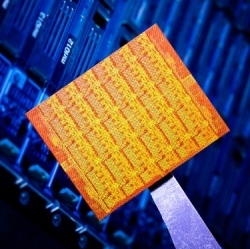
It consists of two coupled single-atom nodes that communicate quantum information via coherent, reversible exchange of single photons.
Besides giving insights into fundamental questions in physics, the finding could also have applications in secure communication and the simulation of complex many-body systems They could also lead to distributed quantum computing.
“This approach to quantum networking is particularly promising because it provides a clear perspective for scalability,” says Professor Gerhard Rempe, director at the Max Planck Institute of Quantum Optics and head of the Quantum Dynamics division.
Background
Quantum information is extremely fragile and cannot be cloned (copied). To prevent alteration or even the loss of the information, it is necessary to have perfect control over all quantum network components. The smallest stationary memory for quantum information is a single atom, and single photons represent the perfect messengers.
Efficient information transfer between an atom and a photon, however, requires strong interaction between the two, which cannot be achieved with atoms in free space.
How it works
To enable strong interaction, the researchers embedded single atoms in optical cavities composed of two highly reflecting mirrors placed at a very short distance apart.
The emission of photons from an atom inside a cavity is directional, so it can be sent to other network nodes in a controlled way. A photon entering the cavity is reflected between the mirrors several thousand times. In this way, the atom-photon interaction is strongly enhanced, and the atom can absorb the photon coherently and with high efficiency.
The first experimental challenge was to quasi-permanently trap the atom in the cavity. This was achieved via fine-tuned laser beams, meaning the least disturbance of the atom. In the next step, the physicists achieved controlled emission of single photons from the trapped atom.
Finally, they could prove that the single-atom-cavity system represents a perfect interface for storing the information encoded in a single photon, and they were able to transfer it onto a second single photon after a certain storage time.
In yet another step, the scientists succeeded in generating “quantum mechanical entanglement” between the two nodes. To do that, the polarization of the single photon emitted by atom A is now entangled with the atomic quantum state. Once the photon gets absorbed, this entanglement gets transferred onto atom B.
Implications for a large-scale quantum network
This is the first time that entanglement has been created between massive particles separated by such a large distance, making it the world’s “largest” quantum system with massive particles, according to the researchers.
This is also another milestone on the way towards a large-scale quantum network, the researchers say. For the first time, two such systems exchanged quantum information with high efficiency and fidelity.
The two systems, each representing a network node, are installed in two laboratories separated by 21 meters and are connected via a 60-meter long optical fiber.
“We were able to prove that the quantum states can be transferred much better than possible with any classical network,” said Dr. Stephan Ritter, leader of the experiment.
“We have realized the first prototype of a quantum network,” according to Ritter. “We achieved reversible exchange of quantum information between the nodes. Furthermore, we can generate remote entanglement between the two nodes and keep it for about 100 microseconds, compared to the generation of the entanglement, takes only about one microsecond.
“Entanglement of two systems separated by a large distance could serve as a resource for the teleportation of quantum information. One day, this might not only make it possible to communicate quantum information over very large distances, but might enable an entire quantum Internet.”
